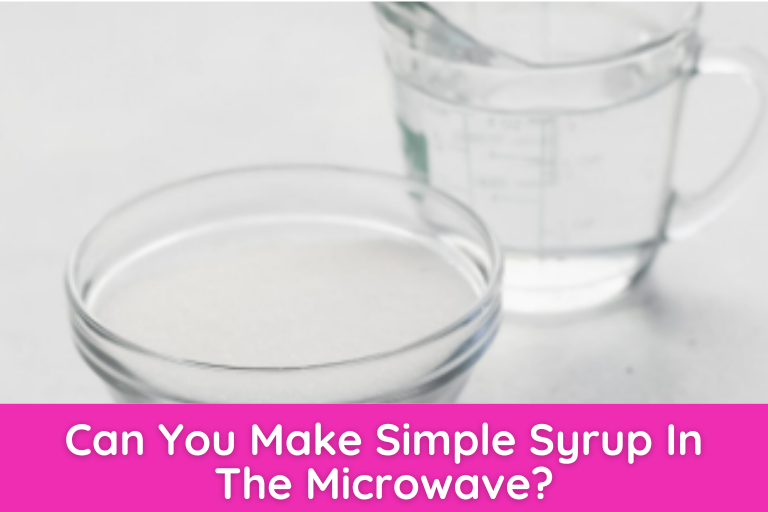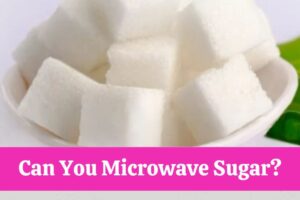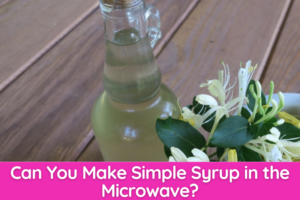Simple syrup is one of the easiest and most convenient ways to add sweetness to beverages, desserts, and other dishes. And now you can make it even simpler by using your microwave!
All you need are a few ingredients and patience – microwave-made simple syrup turns out just as delicious as its stovetop counterpart. So why not give it a try today?
Can You Make Simple Syrup in the Microwave?
Yes, you can make simple syrup in the microwave! All you need is equal parts sugar and water combined in a microwave-safe bowl. Heat for about 2 minutes until it starts to bubble. Stir the mixture until all of the sugar is dissolved, then let it cool before using.
How long do you microwave syrup?
The amount of time you need to microwave simple syrup will depend on how much syrup you are making and the power of your microwave. Generally, microwaving for intervals of 30 to 45 seconds at a time should be enough.
Keep an eye on the syrup and stir it between intervals to ensure it does not burn or overflow. Also, be sure to use a heat-safe dish to avoid damaging your microwave.
Can I boil syrup in the microwave?
Generally speaking, boiling syrup in the microwave is not recommended. While the process may take less time than a stovetop, it cannot be easy to gauge and control the temperature of the syrup.
As a result, the burnt or caramelized syrup may result. If you try boiling syrup in the microwave, make sure to use caution and monitor the process closely.
What temperature do you heat simple syrup?
Simple syrup is usually heated to between 160-180°F (71-82°C). The exact temperature needed will depend on the desired consistency of the syrup.
For example, for a thinner syrup, you may heat it to about 160°F (71°C), and for a thicker syrup, you may need to get it up closer to 180°F (82°C). As you cook, monitor the temperature so that you do not end up with burnt syrup.
What happens if you heat syrup?
When you heat syrup, the sugar in it begins to caramelize, resulting in a change in color and flavor. Depending on what type of syrup you are heating, you may also see bubbles or foam as the mixture boils.
If heated too high or too long, the syrup can begin burning and developing a burnt taste. Be sure to monitor the temperature carefully so that this does not happen.
Is it OK to boil simple syrup?
Yes, it is safe to boil simple syrup. Boiling the syrup helps dissolve any sugar crystals and also further thickens the syrup. When boiling simple syrup, you should watch it carefully, as cooking it for too long or at too high a temperature can cause the mixture to burn. Once it reaches the desired consistency, could you remove it from heat immediately?
What happens when sugar syrup is heated?
The sugar molecules begin to break down and transform when the sugar syrup is heated. This causes a change in color and flavor, resulting in a richer and sweeter syrup.
The boiling temperature of sugar syrup depends on its concentration level: it will boil at temperatures ranging from 219°F (104°C) for a thin syrup to 275°F (135°C) for a thicker syrup.
Boiling too long or too high of a temperature can cause the mixture to burn, so be sure to monitor it carefully.
How do you make simple syrup without a thermometer?
Simple syrup is a solution of equal parts water and granulated sugar. It can be made without a thermometer by bringing the mixture to a boil and simmering until it thickens slightly. You will know the syrup is done when it coats the back of a spoon or reaches the desired consistency. Be sure to stir the mixture periodically during cooking, and keep an eye on it, so it does not burn.
How long does it take for simple syrup to ferment?
Simple syrup can take between one to two weeks to ferment, depending on the yeast being used and other factors such as air temperature. To encourage fermentation, store the simple syrup at a consistent temperature and keep it covered so oxygen cannot enter.
The process of fermentation will convert the sugar into alcohol and carbon dioxide. Once fermentation is complete, the simple syrup can be used in cocktails or other recipes.
What happens if you overcook simple syrup?
If you overcook simple syrup, it can become too thick or may crystallize. This is because the sugar molecules are breaking down into smaller pieces, making them more likely to interact and form crystals.
If this happens, the syrup will be too thick to use in recipes and need to be discarded. To avoid overcooking simple syrup, keep an eye on it while cooking and remove it from the heat once it reaches the desired consistency.
Can you microwave sugar-free syrup?
Yes, you can microwave sugar-free syrup. However, it is not recommended, as microwaving may cause the syrup to bubble over or become too thick. To avoid this, heat the syrup on the stove or in a saucepan on low heat instead. Stir occasionally and remove from heat once it reaches the desired consistency.
At what temperature does syrup melt?
Syrup typically melts at temperatures between 140 and 155 degrees Fahrenheit (60–68 degrees Celsius).
Why is my simple syrup bitter?
There are a few possible reasons why your simple syrup might be bitter. It could be due to using old or expired sugar, not dissolving it completely when preparing the syrup, or boiling it over high heat for too long.
Try reducing the heat while making your simple syrup, and ensure that all sugar is fully dissolved before removing it from the heat.
Why is my simple syrup too thick?
Your simple syrup may need to be thick enough for a few reasons. It could be due to using too much sugar, boiling it at too high of a temperature, or not allowing enough time for the syrup to cool down after cooking. To prevent it from becoming too thick, try reducing the sugar you use and keep an eye on the temperature while boiling your syrup. Be sure to let your syrup cool down before storing or using it.
How to make 50 ml simple syrup?
Making simple syrup is a straightforward process. Here’s what you’ll need:
- 25 grams of sugar
- 50 ml water
- A medium saucepan
- A thermometer (optional)
Instructions:
- Put the sugar and water into the saucepan and boil over medium heat. Stir until the sugar has dissolved.
- If you’re using a thermometer, remove it from the heat once it reaches 110°C (230°F).
- Allow the syrup to cool before using or storing it.
Why do you not stir sugar syrup?
When making sugar syrup, stirring is usually not necessary. The sugar will melt and dissolve into the water on its own. If you decide to stir, do it gently, as stirring can cause air bubbles.
When air bubbles form, they can cause the syrup to crystallize and become grainy. Additionally, avoid stirring when cooking your syrup over high heat, as this may cause the syrup to burn or evaporate too quickly.
Should I boil sugar syrup?
Yes, boiling sugar syrup is an essential part of the process. Bring the sugar and water mixture to a rolling boil over medium heat until the sugar has completely dissolved. If you’re using a thermometer, remove it from the heat once it reaches 110°C (230°F). Stirring while boiling is usually not necessary, but if desired, be sure to do so gently, as stirring can cause air bubbles which can cause the syrup to crystallize and become grainy.
Why is my sugar syrup hardening?
There are several possible causes for hardening sugar syrup. The most common is crystallization when the syrup cools too quickly or contains too much sugar. If this is the case, stirring the syrup gently as it cools can help prevent crystallization.
Another cause of hardening is evaporation, which can occur if the syrup is cooked too long or over high heat. Lastly, impurities such as dust or dirt in the ingredients can cause premature hardening.
How can you tell if the sugar syrup is done without a thermometer?
There are several ways to tell if the sugar syrup is done without a thermometer. The most commonly used method is the cold-water test. To do this, drop a small spoonful of syrup into a bowl of cold water. The syrup has reached the correct stage if it forms a soft ball that can be rolled between your fingers.
Another method is to watch for color and texture changes, such as when the syrup thickens or takes on an amber hue. Lastly, you can use a digital candy thermometer to check the temperature of the syrup without having to take it off the heat.
Conclusion
We hope this article has provided some helpful information about making simple syrup without a thermometer, and we invite readers to share their own experiences of creating these sweet treats. What are some of your best tips for achieving smooth, simple syrups?




